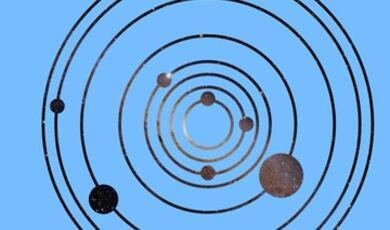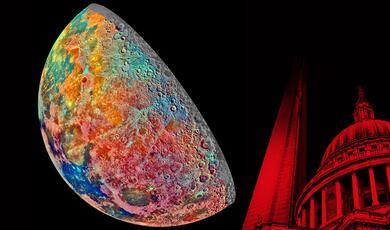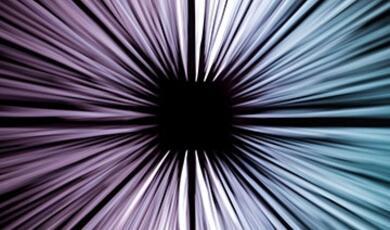Neutrinos - Ghost Particles of the Universe
Share
- Details
- Transcript
- Audio
- Downloads
- Extra Reading
As you read this, millions of neutrinos are passing through you, unseen (and harmless!). Produced in the Sun and stars, they corkscrew through space at hear to the speed of light. They may hold the answer to some of the mysteries of Creation and to the mirror asymmetries of life. Current experiments are looking at the role of neutrinos in the eventual fate of the universe.
Download Transcript
Neutrinos: Ghost Particles of the Universe
Professor Frank Close OBE
As you read this, billions of neutrinos are passing through you - unseen.
These ghostly shy particles are as near to "nothing" as you can imagine, but might contain the secrets to the fate of everything. They are produced in radioactive "beta" decays, in nuclear reactions and in stars, such as the Sun.
They corkscrew through space at, or near, the speed of light (well, that is what the popular texts have said for years, but it might be wrong if some news from Japan is correct - of which more later). Matter is almost transparent to them, hence the oft-quoted phrase "they could pass through a light year of lead without a single lead atom stopping them". (Which is true -almost - and it is the "almost" that has enabled scientists to capture the neutrino and, at last, begin to measure its properties; in particular, to determine whether neutrinos have no mass -like light, and hence travel at the speed of light - or instead have a trifling small but non-zero mass- and hence travel through space at lower speeds).
Neutrinos from the Sun can indeed pass through the Earth as if it were not there.
There are billions of neutrinos "shining" down from above during the day, and they head down through the ground. Nearly all of them will come up from the ground in the Antipodes but a handful of unlucky ones will have hit something along the way. So it is possible to capture an occasional neutrino if you have an intense enough beam to begin with. But for the neutrinos from the Sun, it is true to say that they shine down on our heads by day, and up through our beds by night, almost undimmed. It is clear from this that it is not easy to detect neutrinos. This is one of the major reasons why we know relatively little about them. If they have any mass at all it is exceedingly small - far less than a thousandth of the mass of an electron, the lightest particle (other than the massless photon) that has been measured.
Some statistics about neutrinos:
Currently we are receiving per second about 400,000 billion neutrinos from the sun, (40 billion per cm^2 and I approximate a human surface area as a square metre) but also 50 billion (this number is not well determined) from the natural radioactivity of the Earth. In addition, we emit neutrinos ourselves! Our body contains about 20 milligrams of Potassium-40, which is beta radioactive. As a consequence we emit about 340 million neutrinos per day without knowing it! So every day we emit into space 340 million neutrinos, which interact so rarely that the chances are that most of them will fly forever until the end of the universe!
Which is all very interesting, but you must be asking - "so what?"
Well, it turns out that the Big Bang produced so many neutrinos that there are more of them in the universe than any other known particle, save perhaps photons.
So it a neutrino has even a little bit of mass, the sum total mass of all the neutrinos in the universe could outweigh everything that we currently have seen. Astronomers and cosmologists care about this because they have found that the spectra of light emitted from stars in galaxies "out there" does not match with what would be expected if those galaxies consist only of the stars that we see.
(The spectral light tells us how the stars are moving - as the Doppler shift of sound shows whether a fast car is approaching or going away from us, so the analogous shift in a star's light can tell us which way it is moving). When all the sums are put together, the motion of stars in some galaxies only makes sense if they are experiencing much greater gravitational forces than would be expected from the visible stars in their galaxy. It is as if there is a lot of "dark matter" - stuff that is adding to the gravitational forces but does not emit light to our eyes or telescopes. This is a major problem- to make the sums balance, up to 90 percent of the universe is estimated to consist of this stuff. Could it be neutrinos? Not if they are massless but if they do have a mass then, maybe.
A related question is whether the neutrinos have enough mass that their net effect will be to change the course of the universe. At present the universe is expanding, 15 billion years after the initial Big Bang that started it all. But if neutrinos have mass, their gravity could tug at the stars, eventually slowing their outward flight, reversing the expansion leading to a collapse in a great crunch. Don't panic: this is not going to happen for several billions of years if at all. But it is interesting for the eventual fate of the universe and perhaps of previous universes.
So, how did we learn of neutrinos and what have they taught us. And most interesting today: what is it that the Japanese experiment may have discovered? It was on 4 December 1930 that theorist Wolfgang Pauli wrote a famous letter in which he dared hypothesise the existence of a new particle - now known as a neutrino (he called it the "neutron" in his letter but do not be confused with what today we call the neutron - a particle that is almost the same mass as a proton and that lives in the nucleus of atoms - of which more in another lecture). He clearly predicts that this entity will have a mass less than 1/100 of a proton mass, which is what we know as the neutrino - "LITTLE neutron".
PAULI'S LETTER:-
Dear Radioactive Ladies and Gentlemen,
As the bearer of these lines, to whom I graciously ask you to listen, will explain to you in more detail, how because of the "wrong" statistics of the N and U6 nuclei and the continuous beta spectrum, I have hit upon a deseperate remedy to save the "exchange theorem" of statistics and the law of conservation of energy. Namely, the possibility that there could exist in the nuclei electrically neutral particles, that I wish to call neutrons, which have spin 1/2 and obey the exclusion principle and which further differ from light quanta in that they do not travel with the velocity of light. The mass of the neutrons should be of the same order of magnitude as the electron mass and in any event not larger than 0.01 proton masses. The continuous beta spectrum would then become understandable by the assumption that in beta decay a neutron is emitted in addition to the electron such that the sum of the energies of the neutron and the electron is constant...
I agree that my remedy could seem incredible because one should have seen those neutrons very earlier if they really exist. But only the one who dare can win and the difficult situation, due to the continuous structure of the beta spectrum, is lighted by a remark of my honoured predecessor, Mr De bye, who told me recently in Bruxelles:
"Oh, It's well better not to think to this at all, like new taxes".
>From now on, every solution to the issue must be discussed. Thus, dear radioactive people, look and judge. Unfortunately, I cannot appear in Tubingen personally since I am indispensable here in Zurich because of a ball on the night of 6/7 December.
With my best regards to you, and also to Mr Back.
Your humble servant W. Pauli
Historians may be interested that Pauli was not really a "party person" and the ball was really an excuse to avoid speaking "officially" about his idea, of which he was really unsure at that time.
He proposed it to explain why energy seemed to go missing in the form of radioactivity known as beta decay. While today we invent new particles with abandon, in 1930 it was a revolutionary idea, hence Pauli's caution. The neutrino would take away energy but without being detected, as it had no electric charge and a very small mass. It was to be another 26years before Fred Reines and Clyde Cowan claimed the first detection of Pauli's "undetectable" particle.
In 1945 the first atomic bomb exploded. Despite its horrors, physicists realized that it would be a remarkable source of neutrinos. Reines suggested putting a neutrino detector near to an atomic explosion - although the detector would be destroyed, he calculated that its signals could be recovered. In 1952 he met Clyde Cowan and they realized that a nuclear reactor would be a more "pacific" source of neutrinos. It was in 1956 at the Savannah river reactor, South Carolina, that they were successful. They used a target of 400 litres of water. When a neutrino hits a proton in the water, the neutrino turns into a visible electron (to be pedantic, it is actually the anti-neutrino that they detected and it turned into a positron; the essential point though is that the previously invisible neutrino has become visible by picking up electric charge from the target.
The neutrino emitted in beta decay is accompanied by an electron; and when later this neutrino hits a target, it picks up charge and turns into an electron. We call it an "electron neutrino" as it is always associated in some mysterious way with electrons. By 1960 other ways of producing neutrinos had been discovered. In some of these the neutrino appeared in partnership with a muon - a heavy version of the electron. And these neutrinos seemed to remember this, as when they subsequently hit matter, they pick up charge and turn into - a muon: never an electron. So there appear to be two types of neutrino: one that "remembers" electrons and one that prefers muons. Actually, we now know that there are three varieties, the third being associated with the tau - the third member of the electron and muon family. Why? We don't know; that is what we would like to find out.
Another bizarre feature of neutrinos is that the processes in which they are involved are distinct from their mirror images. If you see a picture of a process involving neutrinos, you can tell whether it is real or a mirror image. This was known as the overthrow of parity. The next surprise was that if the analogous processes took place, but with particles everwhere replaced by their corresponding antiparticles, these looked like the mirror image of the original. To illustrate this idea, which is complicated to visualize in words, I refer to the Escher prints as shown in the talk. The image of the black and white horsemen differs from its mirror image; but replace it by its negative image - which is analogous to the replacement of matter by antimatter - we get back to where we started: black-white reversal is like mirror reversal.
There are however some exotic processes where this combination does not balance perfectly: mirror image and matter to antimatter leaves something that is still different from the original. The Escher print of the swans is analogous to this. Look in the mirror at the negative image and the direction of the tails has changed: in the original the white tails point up but in the final they point down. This is the first example of a clear distinction between matter and antimatter: why? We don't yet know.
Back to the three neutrino varieties, because that is where the current interest is. The fusion processes at the heart of Sun emit neutrinos of the electron variety. Solar physicists understand the workings of the sun very well. From its temperature and other features they can tell us how many neutrinos are emitted each second - 2 * 10^38 per sec! These pour out
in all directions and the numbers that arrive at Earth are 40 billion per cm^2 per sec. This is enough that with a large detector you can hope to capture one or two occasionally. So began the attempts to detect neutrinos from the Sun.
The good news is that these neutrinos have been detected, indeed have been continuously for over 20 years. This proves that the sun is indeed powered by fusion. This is itself a beautiful confirmation of our theories of the sun: with neutrinos we can look into the heart of the sun. However, the actual number seems to be about 2-3 too small. The possibility that we do not understand the sun too well has been exhaustively re-examined (there was even a suggestion that the center of the sun had already burned out - although it would be a hundred thousand years before this affected its outer reaches where our warmth currently comes from, the shortfall of neutrinos from its center could be the first hint of a real energy crisis!). The general opinion is that something is happening to the neutrinos en route: these "electron-friendly neutrinos" are disappearing.
The point is that the detectors on Earth only detect this particular variety, so if the "e-neutrinos" had changed into "mu-neutrinos", say, en route, that could explain the shortfall. Can this happen? Yes, but only if neutrinos have a mass.
In the talk I demonstrated this by use of two pendulums. Each one swinging represents one or other of the "e-nu" and "mu-nu" according to quantum mechanics. If they are massless, they swing independently. But if they have mass, it is analogous to the two pendula being linked by a piece of elastic. We set one swinging and find that this gradually dies out while the other starts swiniging. The analogue is that a "e-nu" starts out from the Sun and "oscillates" into the "mu -nu" en route. By the time the Earth is reached, there is a 50:50 mix of the two. Or if all three varieties of neutrino are linked, one third will be all that we detect here.
Such is the idea: neutrinos have mass and oscillate from one type to the other as they fly through space. Can we test this idea in other ways? Three years ago another example was found - in cosmic rays.
The collisions between cosmic rays and the upper atmosphere produce neutrinos - of the mu-nu and e-nu type in the ratio of 2:1. However, in detectors underground, where all unwanted atomic "noise" but for neutrinos is blocked off, the ratio is found to be more like 1:1. Could it be that this shows that "mu-nu" have oscillated away (remember that this is the converse of the solar case where it is the "e-nu" that are disappearing). The experiments are able to tell the direction that the neutrinos are coming from, even to the extent of telling whether they are coming from above or below. The former are from cosmic interactions in the atmosphere above the ground; the latter are from the corresponding interactions that have taken place on the far side of the planet, the resulting neutrinos then having passed clean through the planet until they were detected. And it does seem that the "mu-nu" have been even more reduced, in accord with the idea that they have travelled further and so had more chance to oscillate away. The clinching proof would be to do some controlled experiments, involving neutrinos produced at earthly accelerator laboratories, and then detected far away to see if their numbers have changed.
This is where the news from Japan comes in.
Plans are afoot to use the neutrino beams from Fermilab, Chicago, and detect them at an underground laboratory in Minnesota; and CERN Geneva is building a beam to be aimed at the Gran Sasso Laboratory, under the mountains near Rome. But the Japanese have already started. Their beams come from the KEK laboratory and they are detected 250 km away at an experiment in the Kamioka Mozumi mine.
The detector consists of a huge tank of pure water, 40m diameter and 40m high. Around its walls are 13000 "photmultiplier tubes" which are very sensitive light detectors. In a way, they are like lightbulbs in reverse in that when a flash of light goes in, electric current comes out and is recorded by computer. The flash of light can be caused by a neutrino hitting protons in the water; a problem is that the light is more likely caused by other things and so a major part of the experiment involves sorting out the needles from the haystack.
The experiment originally became famous when it detected the few neutrinos that arrived in 1987 from the supernova explosion that had taken place 200,000 years ago in the Large Magellanic Cloud galaxy. This was the first time that neutrinos from supernovae beyond our galaxy had been detected. Neutrino astronomy could be said to have been born. Last week they announced the results from their first 100 days af data detecting neutrinos from the KEK laboratory. KEK produce a billion "mu-nu" each second in their beam. By the time they have travelled 250 km the beam has spread out, and the chance of neutrinos hitting protons in the water are also tiny, so only a few hits are expected. In 100 days they expected to detect between 35 and 42 neutrinos; in fact they only saw 28. Various checks convince them that this shortfall is real and that it is probably evidence that the "mu-nu" have oscillated away.
The result so far is tantalising. It is like tossing a coin few times and finding it heads each time. Is it a loaded coin or chance? You need to make more tosses and that in effect is what KEK/Kamioka are doing. Their experiment will continue for years and the data will accumulate. If there is a shortfall it will become precisely measured. It will be compared with the results yet to come from Europe and North America. By comparing the dependence of the "oscillating neutrinos" on distance - because the distances between source and detection vary in these different experiments - it should be possible to tell precisely what the neutrinos are like. If the "mu-nu" is oscillating away, what is it turning into -"e-nu" or "tau-nu"?
We are at the beginnings of knowing if neutrinos have mass - it looks as if they do. What these masses of the different varieties of neutrino are remains to be determined. Precision measurements of neutrinos, and the development of neutrinos astronomy, where we can look deep into the heart of the Sun, of stars and watch supernovae, will be among the exciting stories in the coming years.
This event was on Wed, 13 Mar 2002
Support Gresham
Gresham College has offered an outstanding education to the public free of charge for over 400 years. Today, Gresham plays an important role in fostering a love of learning and a greater understanding of ourselves and the world around us. Your donation will help to widen our reach and to broaden our audience, allowing more people to benefit from a high-quality education from some of the brightest minds.


 Login
Login







